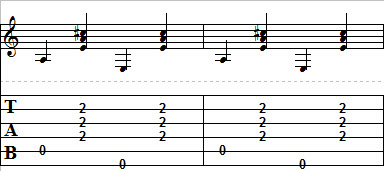In this exercise, instead of adding the percussive strum on beats 2 and 3, we’ll round out the chord voicing.

On beats 1 and 3 you’ll find the alternating bass and in between those notes is the rest of the implied chord. In this case, the implied chord is A. In beat one is a singular A note, beat 2 an A chord is strummed, beat 3 we play the 5th (which is E), and during beat 4 we play the A chord again. The perceived motion is derived from the bouncy bass line that alternates between A and E. The bass line is always the lowest note. In this case, it’s the open A and low E strings.
What we have at this point is the basic alternating bass strum pattern that can be used in a variety of music including blues, folk, and country.
We’ve mastered the A chord, but can you do it with the D chord? Remember, we previously practiced alternating bass for D. We alternated between the open D string and the open A string. Now, try adding the rest of the D chord in between, just like we did for the A chord. I’ll not post any tab for it just yet. See if you can do it on your own and we’ll check your work in our next alternating bass exercise.